CHAPTER 1
Anxiety and Concern
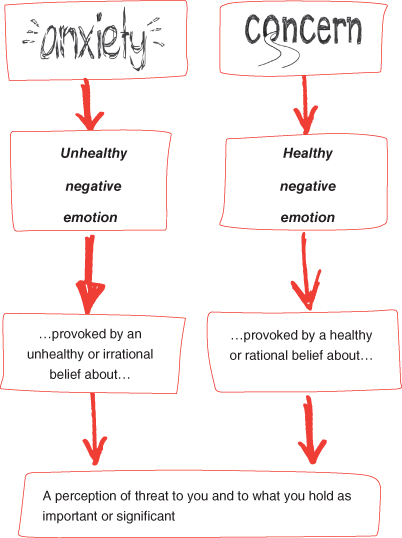
We will focus on the most common forms of anxieties that we see in our private practice.
Anxiety
You can be anxious about a number of things at the same time. For example:
- Being judged negatively
- Anxiety itself
- Not achieving your personal goal
- Failure
- Something happening or not happening.
It is important to understand whether these different anxieties are dependent or independent of each other.
A person might be worried that if they do not perform well they will be judged negatively, and if this was to happen it would mean they are worthless. These two anxieties are therefore dependent on each other; performing well may be hiding the deeper anxiety about negative judgement. In effect, the person is saying that if the possibility of negative judgement didn’t exist then they wouldn’t be anxious about their performance. The main focus of their anxiety is negative judgement and performing well is a strategy designed to avoid negative judgement. In this case the problem is created by an unhealthy belief about negative judgement, i.e. I MUST not be judged negatively and in order for that not to happen I MUST perform well.
Other people may have anxiety about negative judgement and also anxiety about their performance but independently of one another. In other words the anxiety about negative judgement and the anxiety about their performance are mutually exclusive and are two distinct events. In this case there are two independent unhealthy beliefs; one about negative judgement and the other about performance, i.e. I MUST not be judged negatively and I MUST perform according to my expectation. If you asked this person to imagine that people would not judge them negatively regardless of how badly they performed, would they still be anxious about their performance? If they said ‘yes, I would because I really want to do well for me too’, then the two anxieties are not dependent on each other.
If you are anxious about more than one thing, reflect on whether these anxieties are dependent or independent. This will then help you to work out the unhealthy belief or beliefs that are relevant as you work through the chapter.
Anxiety about Anxiety
A common form of anxiety is anxiety about anxiety, i.e. fear of the fear. When you experience anxiety a number of things happen. You clearly feel the emotion of anxiety but you also experience thoughts as well as physical sensations. It is important to ask yourself ‘why is the emotion of anxiety so problematic for me? What do I become worried about when I experience anxiety?’ The following are some common reasons for being anxious about anxiety.
- Fear of negative judgement about looking anxious – they fear others will notice they are anxious or because they might forget what they were saying, tremble, blush or sweat, and that others will negatively judge them for being so.
- Fear of the physical symptoms of anxiety – in a state of anxiety they become aware of their heart beat rising and they worry they might have a heart attack, or they get uncomfortable physical symptoms and pains like dizziness, nausea, headaches, migraines, irritable bowel, losing control of their bowels and so forth, which trigger the anxiety response.
- Fear of the mental symptoms of anxiety – in a state of anxiety their thoughts become jumbled up and they worry that if they can’t control their thoughts they will lose their mind.
- Fear of anxiety attacks – this is known as Panic Disorder. Some people are anxious about being anxious because they worry that in a state of anxiety they might have a panic attack. They may worry that having a panic attack could lead to a heart attack, death, losing control of their mind, losing control of themselves in front of others or some other negative event they view as awful, unbearable or a threat to their self esteem.
Anxiety about Uncertainty
Another common form of anxiety is about uncertainty, although this does not appear to stand alone. We have not encountered any clients who present for therapy complaining about being anxious about uncertainty. What we have encountered are people who are aware of specific threats and risks and demand certainty about them. For example, some people become anxious about physical health and then demand certainty that they are safe from such a risk. They will usually check the internet, regularly seek medical tests and are in a constant state of anxiety because their most cherished desire is certainty that no harm will come to them. Obsessive Compulsive Disorder is essentially about attempting to eliminate risk and sufferers demand certainty and a complete absence of doubt about possible adversities such as contamination, safety and security. Not knowing is therefore extremely uncomfortable. Anxiety about uncertainty can be linked to the threat of making mistakes, making the wrong decisions or not knowing whether something has happened or not.
Generally speaking it is triggered by rigid beliefs and low frustration tolerance beliefs. For example, I MUST be sure that my decision is right, not knowing for sure is intolerable, or I MUST be certain I won’t have depression again and so forth.
Common Anxiety Triggers
The following are common triggers of anxiety – the list is not exhaustive. Some anxieties may be formed around a specific core theme such as perfectionism, control or comfort. Tick the boxes that you think apply to you.
| Tick the box to identify your anxiety triggers |
 Failure Failure |
 Success Success |
 Making mistakes Making mistakes |
 Negative judgement by others Negative judgement by others |
 Approval Approval |
 Not being loved Not being loved |
 Rejection Rejection |
 Loneliness Loneliness |
 Decision making Decision making |
 Blushing Blushing |
 Sweating Sweating |
 Safety Safety |
 Loss of control Loss of control |
 Loss of order Loss of order |
 Certainty Certainty |
 Anxiety itself Anxiety itself |
 Not knowing Not knowing |
 Heart attack Heart attack |
 Negative emotions Negative emotions |
 Effort Effort |
 Health Health |
 Not having positive emotions Not having positive emotions |
 Images or thoughts both judged as shocking or
reprehensible Images or thoughts both judged as shocking or
reprehensible |
 Boredom Boredom |
 Illness Illness |
 Physical symptoms and sensations such as dizziness or
nausea Physical symptoms and sensations such as dizziness or
nausea |
 Loss of bodily functions, i.e. incontinence in public Loss of bodily functions, i.e. incontinence in public |
 Death Death |
 Others feeling angry with you Others feeling angry with you |
 Financial Financial |
 Others not meeting your expectations Others not meeting your expectations |
 Others feeling hurt or upset about something you said
or did Others feeling hurt or upset about something you said
or did |
 Specific thoughts Specific thoughts |
 Confrontation Confrontation |
 Losing your mind Losing your mind |
 Other (write your own reason) Other (write your own reason) |
Am I Anxious or Concerned?
At the heart of your anxiety are unhealthy beliefs about either a perceived or a real threat or danger to you or to what matters to you. The things that matter to you are usually your family, friends, relationships, finance, to name but a few.
Perceived threat is different from real threat in that the threat does not exist in physical reality. It is created by our images and thoughts about a person or situation. For example, anxiety about spiders can happen when a person perceives the small house spider as very large or dangerous when in reality it is a house spider. When we are faced with perceived or real threats, what we believe will determine the level of unhealthy anxiety or healthy concern we feel.
Unhealthy beliefs not only provoke anxiety but they have a consequence on how you think (cognitive consequences), act or tend to act (action tendencies). When you feel anxious, for example, your thoughts may be preoccupied with ‘what if’ and you may avoid or seek constant assurance and reassurance.
Assess if you are anxious or concerned by checking your cognitive consequences and action tendencies.
Look through the illustrations for the cognitive consequences and action tendencies and work out if you are anxious or concerned. It is important to put yourself in the trigger situation when you felt nervous. It is easy to think that you don’t have unhealthy beliefs and thoughts when you are not triggered or when you are away from the threat. Imagine yourself in the frying pan, so to speak, then work out if the nervousness was anxiety or concern.
Cognitive Consequences
Anxiety
You tend to overestimate negative features of the threat.

Cognitive Consequences
Concern
You view the threat realistically.
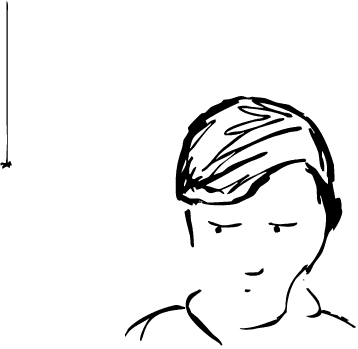
Cognitive Consequences
Anxiety
You underestimate ability to cope with the threat.
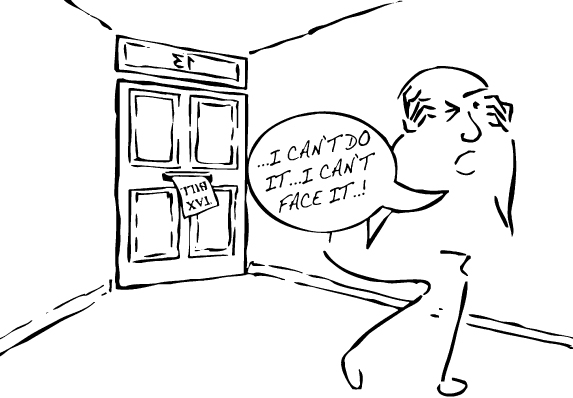
Cognitive Consequences
Concern
You realistically appraise your ability to cope with threat.
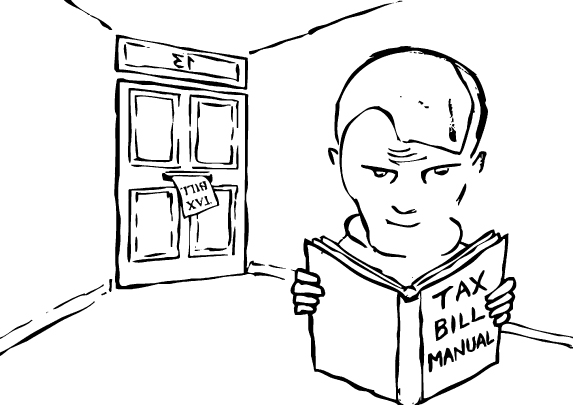
Cognitive Consequences
Anxiety
You create an even more negative threat in your mind.
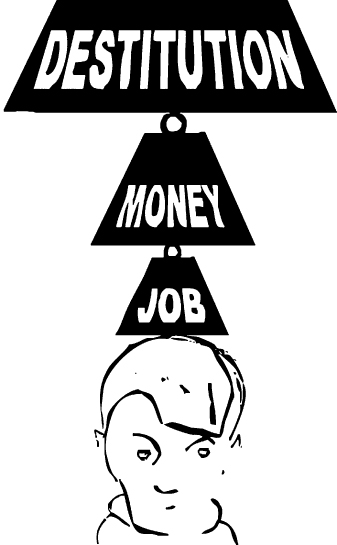
Cognitive Consequences
Concern
You do not create an even more negative threat in your mind.

Cognitive Consequences
Anxiety
You have more task irrelevant thoughts than in concern.

Cognitive Consequences
Concern
You have more task relevant thoughts than in anxiety.
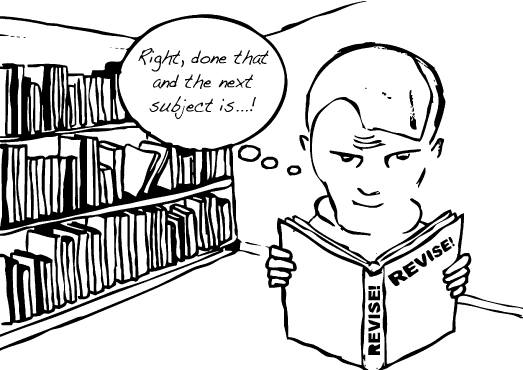
Action/Action Tendencies
Anxiety
You withdraw physically from the threat.
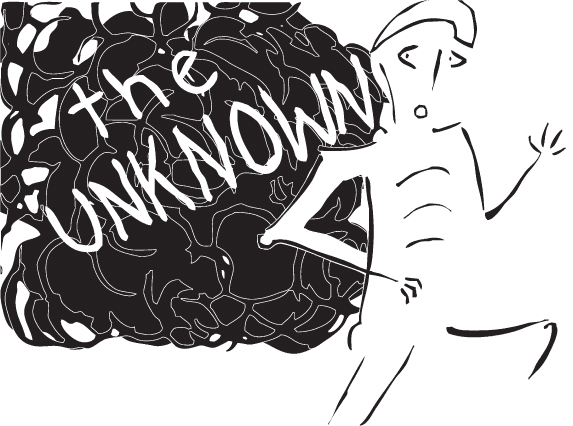
Action/Action Tendencies
Concern
You face up to the threat.
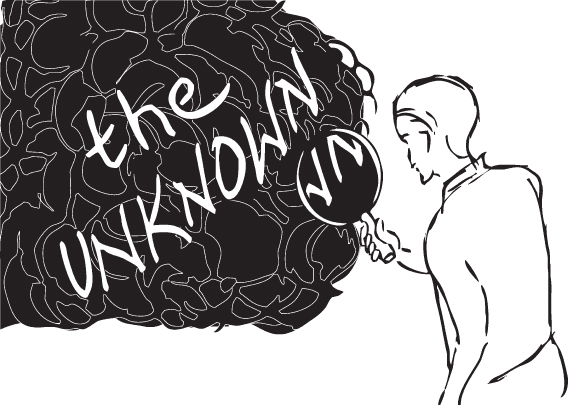
Action/Action Tendencies
Anxiety
You withdraw mentally from the threat.
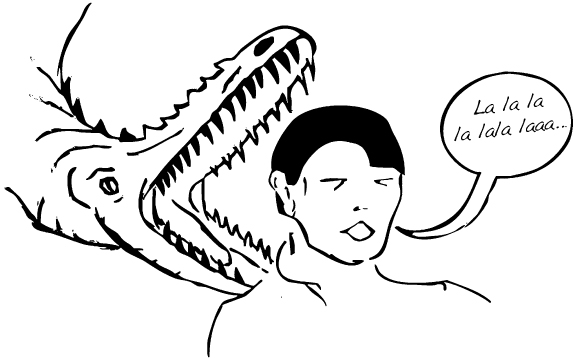
Action/Action Tendencies
Concern
You deal with the threat constructively.

Action/Action Tendencies
Anxiety
You ward off the threat, e.g. with superstition.

Action/Action Tendencies
Concern
You do not ward off the threat, e.g. you have no superstitions.

Action/Action Tendencies
Anxiety
You tranquillise your feelings.
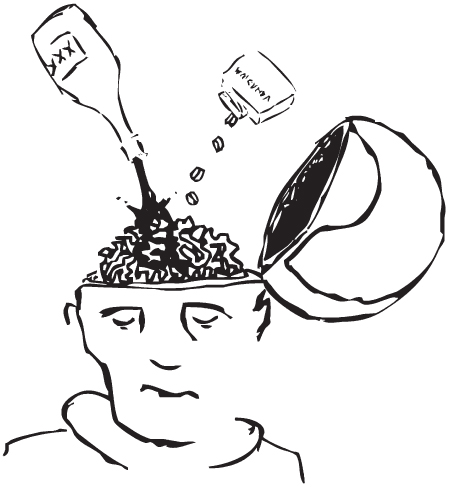
Action/Action Tendencies
Concern
You accept and allow your feelings.

Action/Action Tendencies
Anxiety
You seek reassurance.

Action/Action Tendencies
Concern
You do not seek reassurance.
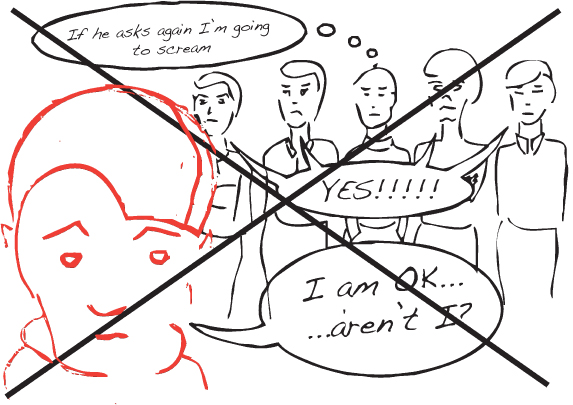
Now …
General Change or Philosophical Change for you?
General Change

Philosophical Change
Remember to take your time if you are choosing this route, as Philosophical Change is about changing your unhealthy beliefs over the long term.
Remember, anxiety is provoked by unhealthy beliefs about perceived or real threats. An unhealthy belief is made up of absolutist rigid beliefs in the form of a MUST, HAVE TO, NEED TO, GOT TO, ABSOLUTELY SHOULD, from which three further derivative disturbed beliefs come.

A rigid unhealthy belief, at B, is a demand about the most anxiety provoking aspect of an event – it is either a demand for it to absolutely happen or absolutely not happen.
For example, if what you are most anxious about is success, then the rigid belief is I must succeed. If what you are most anxious about is failing, then the rigid belief is I must not fail. The consequence of not having the rigid belief met are any, a combination of, or all of the three derivative beliefs.
For example:

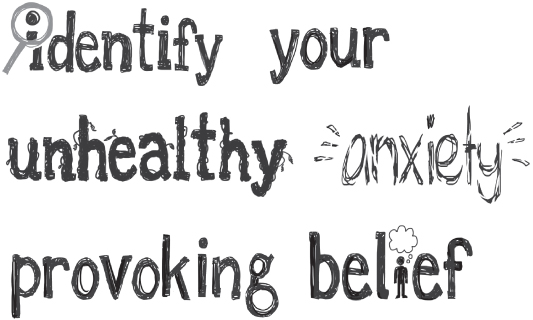
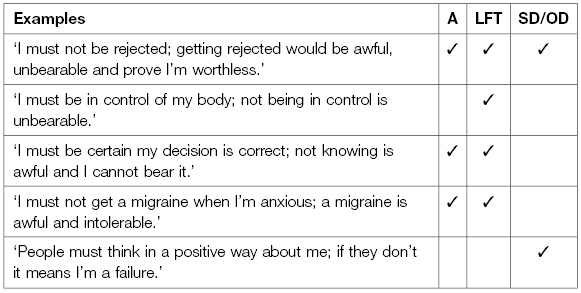
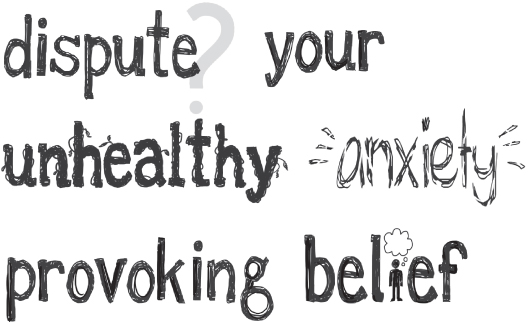
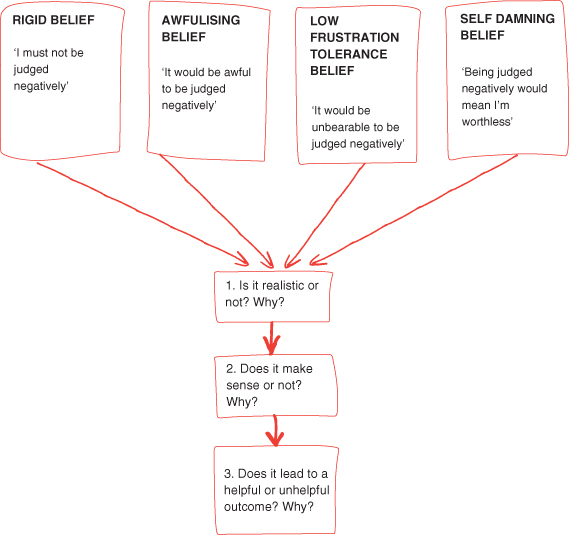
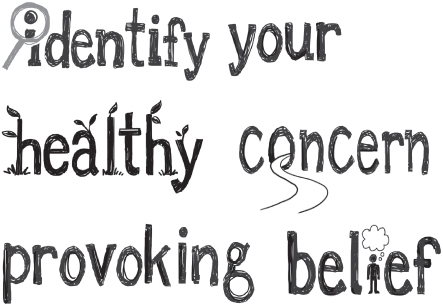

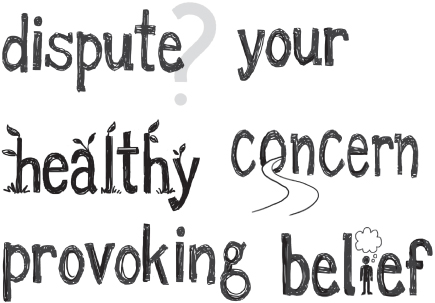
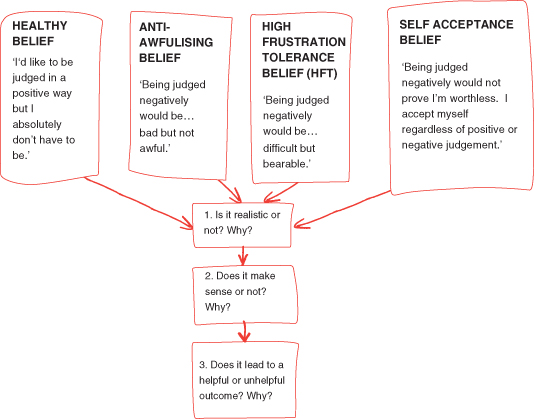
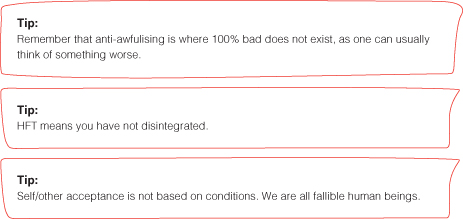


- Think and act in accordance with your healthy belief repeatedly and consistently in a forceful manner until eventually your emotional state changes from anxiety to a healthier one of concern.
- Remember your emotion of anxiety will change – the new way of thinking and the new actions you will implement will feel uncomfortable initially but this is completely natural. You are changing an old habit of unhealthy thinking and old habitual anxiety behaviours. It takes a few weeks of repetitions done consistently and forcefully.
- The behavioural goals you set for yourself need to be challenging but not overwhelming. If you overwhelm yourself then it defeats the object of the exercise.
- Start with imagining yourself thinking and acting in a healthy manner using your healthy belief whilst being in the trigger situation until you think you are ready to challenge yourself in real life. For example, imagining yourself going to the gym is a good start but at some point you will need to take action and go to the gym and then continue until you achieve your desired goal.
- Repeat your healthy belief of concern in your head daily and particularly when you are imagining yourself in the trigger situation. This mental rehearsal will help you to remember it when you deliberately face the trigger situation in real life.
- Once you achieve your desired goal, whatever it is, then you need to maintain the helpful thinking and actions. For example, if you achieve your target weight from going to the gym, it would be unwise to stop completely.
- Review how you did, each time you challenge yourself, and then work out what you can do differently or better the next time. Then do it. Do not demand perfection from yourself. The process of moving from anxiety to concern is uncomfortable and uneven. Some days you will make bigger strides when you challenge yourself and other days you will make small strides or even take a step back. The important thing is to accept that this can happen and then bring your focus back to what you are doing and continue with it.
- Remember, you didn’t learn to drive a car, ride a bicycle or learn to read overnight, it takes repetition and focus and consistency.
Chapter 1 – Anxiety – Takeaway Tips
- To overcome anxiety, it is vital that any avoidance is eliminated. We tend to avoid thoughts, behaviours, feelings, physical sensations, mental images, situations, objects, animals and people. Recite your healthy belief in your head whenever you are feeling like you wish to avoid your particular anxiety provoking situations.
- Learn relaxation techniques but ensure that you are not using relaxation to avoid the feeling of anxiety. Learn relaxation to have a balance in your life.
- Exercise regularly but make sure that you are not using exercising as a strategy to avoid the feeling of anxiety. Exercise to have a healthy lifestyle.
- Challenge yourself but do not overwhelm yourself.
- Face your anxiety triggers bit by bit.
- Repeat, repeat and repeat and be consistent.